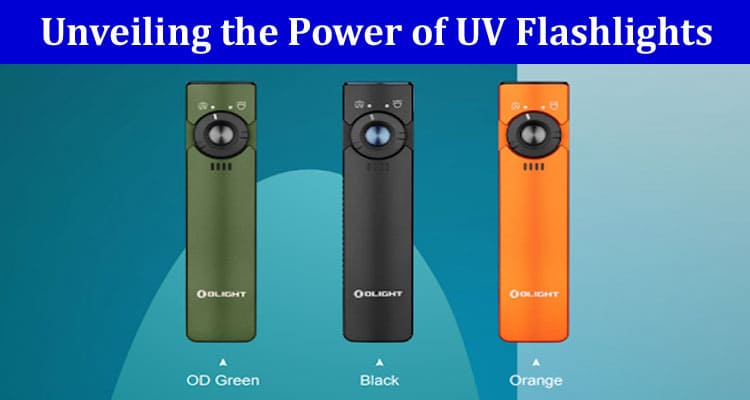UV flashlights, also known as ultraviolet flashlights or black lights, have become increasingly popular due to their ability to reveal a hidden world beyond what the naked eye can see. These powerful tools emit ultraviolet light, a wavelength that is invisible to humans, but can unveil a multitude of fascinating and practical applications. In this article, we will delve into the power of UV flashlights and explore their wide range of uses, from uncovering hidden stains and detecting counterfeit currency to enhancing scientific research and unlocking the wonders of nature.
-
Understanding Ultraviolet Light:
UV light is part of the electromagnetic spectrum, with a wavelength shorter than visible light. It is divided into three categories: UVA, UVB, and UVC. UV flashlights typically emit UVA light, which has the longest wavelength among the three and is the least harmful to human health. Despite being invisible to the naked eye, UVA light can interact with certain substances and cause them to fluoresce, making them visible under UV illumination.
-
Detecting Stains and Contaminants:
One of the most common uses of UV flashlights is in detecting stains and contaminants that are otherwise invisible. For example, urine stains, pet stains, and bodily fluids become visible under UV light, aiding in cleaning and sanitation efforts. UV flashlights are also effective in identifying counterfeit banknotes, as genuine currency often contains fluorescent security features that glow under UV illumination. Furthermore, they can help reveal the presence of certain bacteria or contaminants on surfaces, enhancing hygiene practices.
-
Crime Scene Investigation:
In the realm of forensic science, UV flashlights play a crucial role in crime scene investigation. They can reveal hidden traces of bodily fluids, such as blood or saliva, that may be vital in solving criminal cases. Additionally, UV light can expose fingerprints, even if they are not visible to the naked eye. By illuminating the crime scene with a UV flashlight, investigators can uncover valuable evidence that may otherwise go unnoticed.
-
Gemstone Identification:
UV flashlights are employed in gemstone identification and jewelry appraisal. Some gemstones, such as diamonds, fluoresce under UV light, displaying a characteristic glow that aids gemologists in distinguishing them from imitations or synthetic stones. By examining gemstones under UV illumination, experts can determine their authenticity and assess their quality.
-
Pest Control and Scorpion Hunting:
Certain insects and arachnids, including scorpions, have compounds in their exoskeletons that fluoresce under UV light. By using a UV flashlight, homeowners and pest control professionals can easily spot these pests, making it easier to target and eliminate them. This proves particularly useful in areas where scorpions are prevalent, as their detection can prevent potential stings and ensure a safer environment.
-
Mineral Exploration:
UV flashlights are indispensable tools for mineral collectors and geologists. Many minerals exhibit distinct fluorescence when exposed to UV light, revealing vibrant and captivating colors. This fluorescence can provide valuable information about the mineral composition, aiding in identification and classification. By using a UV flashlight during mineral exploration, enthusiasts can uncover stunning specimens and expand their mineralogical knowledge.
-
Document Authentication:
UV flashlights are commonly used for document authentication purposes. Many official documents, such as passports, driver’s licenses, and identity cards, contain security features that fluoresce under UV light. These features, including special inks, holograms, or watermarks, become visible when exposed to a UV flashlight, ensuring the authenticity and integrity of the document.
-
Aquarium and Pet Care:
UV flashlights are useful tools for aquarium enthusiasts and pet owners. Some organisms, like corals and certain marine fish, exhibit fluorescent pigments that create a mesmerizing display under UV light. By using a UV flashlight, aquarium enthusiasts can enhance the beauty of their underwater ecosystems and appreciate the intricate details of their marine life. UV flashlights can also be used to locate pet urine stains, helping pet owners identify areas that require cleaning and preventing potential odor issues.
-
Scientific Research and Experimentation:
UV flashlights play a significant role in various scientific research fields. They are utilized in fluorescence microscopy, where certain molecules or cellular structures are labeled with fluorescent dyes that respond to UV light. This technique allows researchers to visualize and study intricate biological processes at the microscopic level. UV flashlights are also employed in chromatography experiments, as some compounds exhibit UV fluorescence, aiding in their detection and analysis.
-
Outdoor Adventures and Nature Exploration:
For outdoor enthusiasts and nature lovers, UV flashlights open up a whole new dimension of exploration. In the wilderness, UV light can unveil hidden patterns and fluorescent markings on plants, flowers, and insects. Some minerals and rocks in natural environments exhibit UV fluorescence, creating a breathtaking spectacle for those equipped with a UV flashlight. Exploring caves and geological formations with UV light can reveal unique and captivating features that are otherwise invisible.
In conclusion, UV flashlights have the remarkable ability to illuminate the invisible and uncover hidden details in various applications. From stain detection and crime scene investigation to gemstone identification and scientific research, these versatile tools have proven their worth across numerous fields. Whether you are a homeowner, investigator, scientist, or outdoor enthusiast, a UV flashlight can be a valuable addition to your toolkit. Embrace the power of UV light and embark on a journey of discovery, as you unveil the hidden wonders that lie beyond the visible spectrum.


